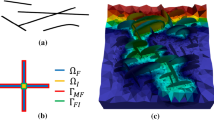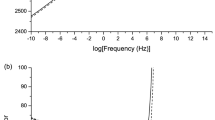Abstract
We compare the exact normal-incidence PP reflection coefficient [Geertsma–Smit expression] to approximations reported by several authors, based on open-pore boundary conditions at a plane interface between two porous media. The approximations correspond to low frequencies. Two of them are derived from the low-frequency Biot theory below the Biot characteristic frequency, but the results show significant differences much below the Biot frequency. Then, we extend the Geertsma–Smit equations by including the high-frequency viscodynamic operator (i.e., the full-frequency range Biot theory), showing that there are additional substantial differences at the high-frequency range. Use of this latter expression is required to honor the physics in the whole frequency range. We further generalize the Geertsma–Smit equations to the case of general boundary conditions other than the open-pore interface. At the seismic band, it is shown that the lossless (elastic) expression based on the Gassmann P-wave impedance is the reflection coefficient to use for practical applications. It is inferred that interpretations based on the frequency dependency of these approximations can be misleading, since this dependency does not provide a suitable description of the physics.










Similar content being viewed by others
References
Allard JF (1993) Propagation of sound in porous media, modelling sound absorbing materials. Elsevier Sci. Pub. Ltd., London
Biot MA (1956a) Theory of propagation of elastic waves in a fluid-saturated porous solid. I. Low-frequency range. J Acoust Soc Am 28:168–178
Biot MA (1956b) Theory of propagation of elastic waves in a fluid-saturated porous solid. II. High-frequency range. J Acoust Soc Am 28:179–191
Biot MA (1962) Generalized theory of acoustic propagation in porous dissipative media. J Acoust Soc Am 34:1254–1264
Bourbie T, Coussy O, Zinzner B (1987) Acoustics of porous media. Gulf Publishing Company, Houston
Carcione JM (1998) Viscoelastic effective rheologies for modeling wave propagation in porous media. Geophys. Prosp. 46:249–270
Carcione JM (2014) Wave fields in real media. Theory and numerical simulation of wave propagation in anisotropic, anelastic, porous and electromagnetic media, 3rd edn, revised and extended, Elsevier Science
Carcione JM, Campanella O, Santos JE (2007) A poroelastic model for wave propagation in partially frozen orange juice. J Food Eng 80:11–17
Carcione JM, Picotti S (2006) P-wave seismic attenuation by slow-wave diffusion. Effects of inhomogeneous rock properties. Geophysics 71:O1–O8
Carcione JM, Quiroga-Goode G (1995) Some aspects of the physics and numerical modeling of Biot compressional waves. J Comput Acoust 3:261–280
Denneman AIM, Drijkoningen GG, Smeulders DMJ, Wapenaar K (2002) Reflection and transmission of waves at a fluid/porous-medium interface. Geophysics 67:282–291
Deresiewicz H, Rice JT (1964) The effect of boundaries on wave propagation in a liquid-filled porous solid: V. Transmission across a plane interface. Bull Seism Soc Am 54:409–416
Deresiewicz H, Skalak R (1963) On uniqueness in dynamic poroelasticity. Bull Seism Soc Am 53:783–788
Dutta NC, Odé H (1983) Seismic reflections from a gas-water contact. Geophysics 48:1–2
Geertsma J, Smit DC (1961) Some aspects of elastic waves propagation in fluid-saturated porous solids. Geophysics 26:169–181
Goloshubin G, Silin D, Vingalov V, Takkand G, Latfullin M (2008) Reservoir permeability from seismic attribute analysis. Lead Edge 27:376–381
Gurevich B (1994) Discussion on: “Wave Propagation in heterogeneous, porous media: a velocity-stress, finite difference method,” by N. Dai, A. Vafidis, and E. R. Kanasewich (March–April 1995). Geophysics 327–340
Gurevich B, Ciz R, Denneman AIM (2004) Simple expressions for normal incidence reflection coefficients from an interface between fluid-saturated porous materials. Geophysics 69:1372–1377
Gurevich B, Lopatnikov SL (1995) Velocity and attenuation of elastic waves in finely layered porous rocks. Geophys J Int 121:933–947
Gurevich B, Marschall R, Shapiro SA (1994) Effect of fluid flow on seismic reflections from a thin layer in a porous medium. J Seism Explor 3:125–140
Gurevich B, Schoenberg M (1999) Interface boundary conditions for Biot’s equations of poroelasticity. J Acoust Soc Am 105:2585–2589
Johnson DL (1982) Elastodynamic of gels. J Chem Phys 77:1531–1539
Johnson DL, Koplik J, Dashen R (1987) Theory of dynamic permeability and tortuosity in fluid-saturated porous media. J Fluid Mech 176:379–402
Johnson DL, Plona T (1982) Acoustic slow waves and the consolidation transition. J Acoust Soc Am 72:556–565
Krief M, Garat J, Stellingwerff J, Ventre J (1990) A petrophysical interpretation using the velocities of P and S waves (full waveform sonic). Log Analyst 31:355–369
Li S, Rao Y (2020) Seismic low-frequency amplitude analysis for identifying gas reservoirs within thinly layered media. J Geophys Eng 17:175–188
Mavko G, Mukerji T, Dvorkin J (2009) The rock physics handbook. Cambridge Univ. Press, Cambridge
Pride SR, Harris JM, Johnson DL, Mateeva A , Nihel KT, Nowack RL, Rector JW, Spetzler H, Wu R, Yamomoto T (2003) Permeability dependence of seismic amplitudes. Lead Edge 22:518–525
Quiroga-Goode G, Carcione JM (1997) Wave dynamics at an interface in porous media. Boll Geos Teor Appl 38:165–178
Rasolofosaon PNJ (1988) Importance of interface hydraulic condition on the generation of second bulk compressional wave in porous media. Appl Phys Lett 52:780–782
Rosenbaum JH (1974) Synthetic microseismograms: logging in porous formations. Geophysics 39:14–32
Silin DB, Goloshubin GM (2010) An asymptotic model of seismic reflection from a permeable layer. Transp Porous Media 83:233–256
Silin DB, Korneev VA, Goloshubin GM, Patzek TW (2006) Low-frequency asymptotic analysis of seismic reflection from a fluid-saturated medium. Transp Porous Media 62(3):283–305
Xu D, Wang Y, Gan Q, Tang J (2011) Frequency-dependent seismic reflection coefficient for discriminating gas reservoirs. J Geophys Eng 8:508–513
White JE, Mikhaylova NG, Lyakhovitskiy FM (1975) Low frequency seismic waves in fluid saturated layered rocks. Izvestija Acad Sci USSR Phys Solid Earth 11:654–659
Zhou D, Yin X, Zong Z (2020) Closed-form expressions of plane-wave reflection and transmission coefficients at a planar interface of porous media with a normal incident fast P-wave. Geophys Pure Appl. https://doi.org/10.1007/s00024-019-02383-1
Funding
Funding was provided by Jiangsu Province Science Fund for Distinguished Young Scholars (Grant Number BK20200021), the National Natural Science Foundation of China (grant no. 41974123) and the Jiangsu Innovation and Entrepreneurship Plan.
Author information
Authors and Affiliations
Corresponding author
Additional information
Publisher's Note
Springer Nature remains neutral with regard to jurisdictional claims in published maps and institutional affiliations.
Appendix A: Approximations of the Normal-Incidence Reflection Coefficient
Appendix A: Approximations of the Normal-Incidence Reflection Coefficient
1.1 A.1 Bourbie et al. Equations
The normal-incidence PP reflection coefficient at an interface separating the incidence medium 1 and the transmission medium 2 reported by Bourbie et al. (1987) is
where
where \(\omega\) is the angular frequency, \(K_m\) and \(\mu\) are the dry-rock bulk and shear moduli, respectively, \(\rho _s\) and \(\rho\) are the solid and bulk densities, respectively, \(\kappa\) is permeability, and \({\mathrm{i}}= \sqrt{-1}\).
1.2 A.2 Gurevich et al. Equations
Gurevich et al. (2004) approximations of the wavenumbers of the fast and slow waves are (their Eqs. 10 and 11),
to be compared with the exact ones, obtained from the dispersion Eq. (5).
Gurevich et al. (2004, Eq. 22) PP reflection coefficient is
where
1.3 A.3 Silin and Goloshubin expression
The normal-incidence PP reflection coefficients at an interface separating the incidence medium 1 and the transmission medium 2 reported by Silin and Goloshubin (2010, their Eq. 88; see Eqs. 9, 15, 24, 35, 64, 75, 78, 84-87) is
where
Note that \(I_j\) [Eq. (28)] are not Gassmann impedances \(\left( \sqrt{\rho _j E_{mj}}\right)\) as in the other approximations. Since subindex k is undetermined in Silin and Goloshubin (2010) [see Eq. (26)], we consider two reflections coefficients, corresponding to \(\epsilon\) of medium 1 (\(k = 1\)) and \(\epsilon\) of medium 2 (\(k = 2\)).
Rights and permissions
About this article
Cite this article
Carcione, J.M., Gei, D., Gurevich, B. et al. On the Normal-Incidence Reflection Coefficient in Porous Media. Surv Geophys 42, 923–942 (2021). https://doi.org/10.1007/s10712-021-09646-4
Received:
Accepted:
Published:
Issue Date:
DOI: https://doi.org/10.1007/s10712-021-09646-4




